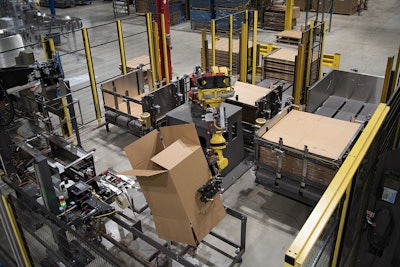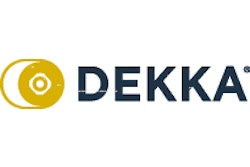The Ring Container Technologies blow-molding plant in Hanover, PA, recently installed flexible automation for its end-of-line packaging system that includes hands-free case erecting, tumble packing, palletizing, and stretch wrapping.
“This new end-of-line packing system can access on-the-fly information about which one of three cases to erect next, and then direct the case along the line from tumble filling to stretch-wrapped eight-foot-high pallets, all hands-free,” says Kevin Frye, Executive Director of Engineering, Ring Container Technologies. “This system isn’t where flexible automation is evolving, but rather where it has evolved.”
The 125,000-sq-ft Ring plant in Hanover is a highly-automated PET blow-molding facility strategically located near its customers for the benefits of just-in-time delivery. A new customer for Ring recently presented a difficult packaging challenge that one of the company’s engineers believed could be solved with state-of-the-art track-and-trace information integrated into flexible systems.
The customer wanted eight different PET food containers delivered on demand. Each pallet was to carry cases of the same product, so that the pallets and cases could be taken all together to the correct filling line. Each style bottle would have a specified case count, which meant that three different-sized cases were required for the eight distinctive bottles. Cases needed a bag liner to minimize corrugated dust on the bottles. Each type of bottle would fill a case at a different rate. Therefore, case erection would occur in random order with cases arriving at the tumble filler just in time.
Waste reduction was an important factor for Ring and for the customer. The process would involve cases being sent back to Ring for reuse. Polyethylene liners would be collected and recycled. The cases would be taped, so the tape used had to be easy to remove. This meant there would be a mix of new and used cases being fed into the case erector. Surface porosity of new and used corrugated varies, making vacuum-based handling for case erection and palletizing problematic.
For many years, Ring has worked closely with Brenton Engineering, a Pro Mach brand, on turnkey custom solutions for case erecting, packing, and palletizing. Knowing that the mixed new and used cases presented a unique case-erection challenge, the two companies started looking at potential solutions.
“We studied case erectors,” Frye says about the initial specification setting sessions. “We also considered robotics. We concluded the best scenario would be a robotic-based case-erector system, one capable of handling mixed used and new corrugated. The most innovative idea to come out of these planning meetings was to have a single robot handle the three different-sized cases on demand and with zero changeover time.”
The key to the success of a one-robot cell was a robust end-of-arm tool (EOAT) with a vacuum gripper optimized for gradations in porosity. The most important advantages of one robot erecting three different cases included:
- The cost-effectiveness of one unit handling all three cases
- A small footprint
- Ease of maintenance of a single piece of equipment
- The high uptime of robots
- The most efficient utilization of labor in terms of loading case blanks into a single cell, not into individual machines
The benefits of having a small footprint, and the cost effectiveness and uptime advantages of a single-robot case erector at the front of the line led the design team to come up with the suggestion of a single robot for palletizing. Brenton proposed four palletizing stations—one station per blow-molding line. In most palletizing operations, one robot handles two pallet stations. With the Brenton design, one robot on a rail could pack four pallets and do so as cases arrived in random order. Once packed, each pallet would be moved via power conveyor to a fully automated turntable stretch wrapper.
At the beginning of each shift in Ring’s new system, case blanks are loaded onto infeed conveyors at the robotic case-erecting cell. Only one loading is required per shift for minimized handling. The robot erects 10 to 15 cases/min. A Fanuc R1000iA six-axis robot then picks one of three case blanks to replenish the case-filling system, as demand requires. The EOAT squares the case and then presents it to a tape head from Dekka Industries, a Pro Mach brand, to seal the bottom flaps.
Following bottom case taping, the upper flaps of the case are pressed downward before the case enters the OK International Corp. (OKI) polybag maker and inserter. To minimize material consumption and achieve maximum flexibility, the OKI machine automatically measures a length of PE film appropriate for the case size, cuts and inserts the individually-sized bag into the case, and then cuffs the bag around the case. Both the case erection and bag insertion stations feature Allen-Bradley Plus 6-1000 HMI touchscreens.
Cases on the line are labeled by an ID Technology (a Pro Mach brand) label printer/applicator with 2D barcode information, which is vital to the Ring warehouse management system in terms of tracking and tracing each case and its status. Cognex DataMan 300 series vision sensors are placed strategically throughout the line as a quality measure.
Next, a TGW 24-v motor-driven roller conveyor routes cases to one of four blow-molding-line filling spurs. Once cases are tumble filled, they travel over the leveling section of the conveyor to level the bottles in the case. After going through a bag uncuffing and sealing station, cases are sealed with an 800RF automatic random-height case sealer from 3M that tapes the top flaps closed in preparation for the robotic palletizing process.
When cases arrive in random order at the palletizing station, the labels are scanned by a Cognex unit to verify which filling line the case came from. A Fanuc M410iC-185 four-axis industrial palletizing robot picks single cases and travels via a Vizient rail system to the correct station in the four-station palletizing cell. The robot builds stable truck-sized loads of up to 8.75 ft high. Each pallet features a single-style bottle, and each pallet receives cases in the order in which they arrive at the cell. Stacks of empty 48 x 40 GMA-style (Grocery Manufacturers Assn.) pallets are deposited in a fork-style automated pallet dispenser. As a pallet station becomes free, the next pallet automatically moves into that station. An Allen-Bradley Plus 6-1000 HMI touchscreen is provided for operators to interface with the robotic palletizing cell.
Once a pallet is fully loaded, it is routed via powered conveyor to an automatic FA turntable-style stretch wrapper from Orion Packaging, a Pro Mach brand. Every stretch-wrapped pallet receives labels on two panels from an ID Technology label printer/applicator. This information is logged into the WMS, and the pallet is discharged from the hands-free system.
The packing line, under the supervision of a Project Management Professional-certified project manager, was completed by Brenton Engineering in about six months. The turnkey system was integrated and operated at the Brenton Center of Excellence in Alexandria, MN, for the Factory Acceptance Test (FAT). The test also included operator training. Frye credits the turnkey approach for rapid start-up—one week for installation and four weeks for ramp up.
See four other case histories in Part 1 of Packaging World's Robotics & Automation Special Report.































